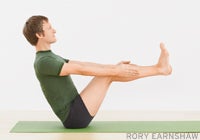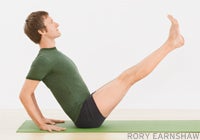Heading out the door? Read this article on the new Outside+ app available now on iOS devices for members! Download the app.
You’ve probably heard that Paripurna Navasana (Full Boat Pose) builds core strength. But in yoga, the “core” refers to more than just abs. B.K.S. Iyengar says that practice leads you on an inward journey from the periphery of your body to the core of your being. With Navasana, you’ll build strong abdominal muscles that can help support your lower back.
The process of coordinating the work of your limbs and your torso while strengthening your spine will also teach you about your breath, your attention span, your emotions, and your very nature. Eventually, even a simple pose like Navasana can penetrate beyond the muscles, nerves, bones, and organs to your Self—your innermost core. Navasana is a compact pose that requires you to draw everything toward your center: The abdomen moves toward the spine, the spine moves forward to support the front of the trunk, the shoulder blades move down and in toward the chest, while the chest spreads, and the arms and legs stay firm. The integration of all of your body parts in Full Boat Pose will leave you feeling strong and supple as well as mentally and emotionally steady.
But if your mind wanders, the inner firmness you’ve cultivated will waver and you’ll lose your balance. So, to find your inner core and stability in the pose, keep your face soft and your breath relaxed. The idea is that when your brain is tense and your eyes bulge, your focus becomes external. When your facial features recede, however, your attention draws inward, and you can find stability again.
Although Navasana will work your core muscles, it’s no gym crunch. Instead of bringing your chest and pelvis close together and shortening the front body, you’ll pull your ribs away from the abdomen to lift the chest—all while balancing on your buttocks. You’ll discover how to engage and stretch the abdomen simultaneously. Lengthening the front body like this is an essential action for many asana and Pranayama techniques. It supports the entire chest cavity (as opposed to a tight, short front body, which puts pressure on the lungs, internal organs, and lower back), and it can facilitate smooth and efficient breathing as you do your asana practice or go about your day.
Pose Benefits:
- Relieves bloating and gas
- Strengthens the abdomen and back
Contraindications:
- Pregnancy
- Menstruation
- Diarrhea
Half-Mast

Full Boat Pose is like a balancing version of Dandasana (Staff Pose), so if you cannot sit up straight in Dandasana because of tight hamstrings, you may find it difficult to bring your legs toward your torso without rounding your back and sinking into your chest. Bending your knees in the first variation takes your hamstrings out of the equation, enabling you to practice the pose without sagging in the spine. If your abdomen, back, or legs are weak, the second variation will show you how to lift your spine. Both variations give you the opportunity to learn the pose gradually so that you can experience the dynamics of the back, legs, and abdomen working together to bring you into your core.
To do Navasana with bent knees, begin by sitting in Dandasana, and then place your palms on the floor beside your hips. Press your thighs down and stretch your heels away from your pelvis to fully straighten your legs. Lift your torso away from the floor and open your chest. Your back should feel as though it’s moving forward, toward the front of your body. Now lift the front of your body all the way from the bottom of your pelvis to the top of your chest. To create some space between your torso and legs, press the very tops of your thighbones into the floor and lift the bottom of your abdomen up away from your thighs without leaning on the back of your buttocks. Lift your rib cage away from your abdomen and roll your shoulders back.
Next, bend your knees and place your feet on the floor. Hold the tops of your knees with your hands and pull on them slightly to lift your sternum. Raise your feet until your shins are parallel to the floor, and then flex your feet. With your legs touching and knees still bent, bring your thighs closer to your chest, and lift your chest.
Balanced to the Core
Now that you are balancing on your buttocks, see that you’re not rounding your back. Move your spine forward, toward your front body. Pull on your bent knees once again to lift your chest and increase the distance between your sternum and your navel. Without dropping your chest, stretch your arms out in front alongside your shins, parallel to the floor, palms facing each other. Notice how your abdominal muscles engage as you pull your thighs closer to your torso. Don’t let your back round, but see if you can lengthen the front of your torso more.
Even as you stretch your arms forward, pull your shoulders back and move your shoulder blades down and in toward your chest. Although simultaneously engaging and lengthening your abdomen is challenging, these actions bring your attention inward toward the source of your movements and help keep you internally focused. Breathe normally, relax your throat, and look straight ahead. You can hold the pose initially for 30 seconds, and then work up to one minute. When you’re ready, exhale and place your feet on the floor to return to Dandasana.
Anchored and Steady

In the second variation you’ll balance in Navasana with straight legs while keeping your hands on the floor to help you feel steady and support the lift of your spine. Start in Dandasana. Lean back slightly and place your palms a few inches behind your hips. Lift your chest, bend your knees, and raise your legs until your shins are parallel to the floor. Bring your thighs toward your torso, and move your back ribs and shoulder blades forward. Exhale and straighten your legs without rounding your back. Extend from your calves to your heels until your toes are about as high as your head. You’ll feel your abdomen working, but don’t let the front of your body shorten. Instead, lift your navel toward your chest and your ribs off your abdomen. Roll your shoulders back and look ahead.
It doesn’t take long in this pose to realize that your legs work hard to remain straight and uplifted. So, as you do in Dandasana, press your thighs to the back of your legs and extend your calves toward your heels. Reach out through your inner heels and broaden the soles of your feet. Use your hands to help balance yourself without tilting back. Breathe smoothly and keep your face and throat relaxed. Let the effort to become tall and balanced be supported by your inner body without outward strain so that your mind remains quiet. Then exhale, bend your knees, and place your feet back on the floor.
Love Boat

Now you’re prepped and ready to practice Full Boat Pose. If you find that your back or legs won’t let you hold yourself up without sinking in the spine, you can support your heels on a wall or tall chair.
Start in Dandasana, and again lean back on your hands. Lift and straighten your legs as you did in the second variation. Now come onto your fingertips and lift your lower back so that your entire spine feels as though it is moving toward the front of your body. Lift your arms and stretch them evenly out in front of you, parallel to the floor. Keep your palms extended, facing each other. Stretch your fingers forward and pull your shoulders back and down as you lift your sternum.
Keep your knees firm and tight to maintain straight legs. Extend the inner legs toward your inner heels and spread the balls of your feet from your big toe toward your little toe. Without bending your knees, work toward lifting your legs higher so that your feet rise above the level of your head. Lift your chest while keeping your chin level and your throat soft. Look straight ahead, perhaps at your feet, as you hold the pose for 30 to 60 seconds. Then exhale and release your legs to the floor. Lie down on your back with your knees bent to rest. Allow your abdomen to release toward the back of your body and your back to press into the floor.
Holding yourself up and lengthening your arms, legs, abdomen, and chest in Paripurna Navasana draws your focus inward. Despite the effort involved, connecting to the stability of your core can be calming and centering to your body, mind, and emotions. Contact with this center of your being is like finding silence in the midst of a storm. Despite the many actions involved in this pose, the result of those actions can draw you closer to your own source of calm stillness.
Marla Apa is a certified Iyengar Yoga instructor in Los Angeles.